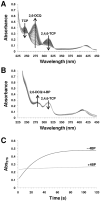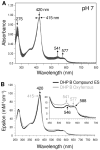Spectroscopic and mechanistic investigations of dehaloperoxidase B from Amphitrite ornata
- PMID: 20545299
- PMCID: PMC2921985
- DOI: 10.1021/bi100407v
Spectroscopic and mechanistic investigations of dehaloperoxidase B from Amphitrite ornata
Abstract
Dehaloperoxidase (DHP) from the terebellid polychaete Amphitrite ornata is a bifunctional enzyme that possesses both hemoglobin and peroxidase activities. Of the two DHP isoenzymes identified to date, much of the recent focus has been on DHP A, whereas very little is known pertaining to the activity, substrate specificity, mechanism of function, or spectroscopic properties of DHP B. Herein, we report the recombinant expression and purification of DHP B, as well as the details of our investigations into its catalytic cycle using biochemical assays, stopped-flow UV-visible, resonance Raman, and rapid freeze-quench electron paramagnetic resonance spectroscopies, and spectroelectrochemistry. Our experimental design reveals mechanistic insights and kinetic descriptions of the dehaloperoxidase mechanism which have not been previously reported for isoenzyme A. Namely, we demonstrate a novel reaction pathway in which the products of the oxidative dehalogenation of trihalophenols (dihaloquinones) are themselves capable of inducing formation of oxyferrous DHP B, and an updated catalytic cycle for DHP is proposed. We further demonstrate that, unlike the traditional monofunctional peroxidases, the oxyferrous state in DHP is a peroxidase-competent starting species, which suggests that the ferric oxidation state may not be an obligatory starting point for the enzyme. The data presented herein provide a link between the peroxidase and oxygen transport activities which furthers our understanding of how this bifunctional enzyme is able to unite its two inherent functions in one system.
Figures









Similar articles
-
Tyrosyl radicals in dehaloperoxidase: how nature deals with evolving an oxygen-binding globin to a biologically relevant peroxidase.J Biol Chem. 2013 Nov 15;288(46):33470-82. doi: 10.1074/jbc.M113.496497. Epub 2013 Oct 6. J Biol Chem. 2013. PMID: 24100039 Free PMC article.
-
Reactivity of deoxy- and oxyferrous dehaloperoxidase B from Amphitrite ornata: identification of compound II and its ferrous-hydroperoxide precursor.Biochemistry. 2011 Jul 12;50(27):5999-6011. doi: 10.1021/bi200311u. Epub 2011 Jun 15. Biochemistry. 2011. PMID: 21619067 Free PMC article.
-
Characterization of dehaloperoxidase compound ES and its reactivity with trihalophenols.Biochemistry. 2009 Feb 10;48(5):995-1005. doi: 10.1021/bi801916j. Biochemistry. 2009. PMID: 19187035
-
Peroxidase versus Peroxygenase Activity: Substrate Substituent Effects as Modulators of Enzyme Function in the Multifunctional Catalytic Globin Dehaloperoxidase.Biochemistry. 2018 Jul 31;57(30):4455-4468. doi: 10.1021/acs.biochem.8b00540. Epub 2018 Jul 13. Biochemistry. 2018. PMID: 29949340
-
The dehaloperoxidase paradox.Biochim Biophys Acta. 2012 Apr;1824(4):578-88. doi: 10.1016/j.bbapap.2011.12.008. Epub 2012 Jan 3. Biochim Biophys Acta. 2012. PMID: 22248447 Review.
Cited by
-
Complementarity of neutron, XFEL and synchrotron crystallography for defining the structures of metalloenzymes at room temperature.IUCrJ. 2022 Jul 25;9(Pt 5):610-624. doi: 10.1107/S2052252522006418. eCollection 2022 Sep 1. IUCrJ. 2022. PMID: 36071813 Free PMC article.
-
Tyrosyl radicals in dehaloperoxidase: how nature deals with evolving an oxygen-binding globin to a biologically relevant peroxidase.J Biol Chem. 2013 Nov 15;288(46):33470-82. doi: 10.1074/jbc.M113.496497. Epub 2013 Oct 6. J Biol Chem. 2013. PMID: 24100039 Free PMC article.
-
Functional consequences of the creation of an Asp-His-Fe triad in a 3/3 globin.Biochemistry. 2011 Nov 8;50(44):9664-80. doi: 10.1021/bi201368u. Epub 2011 Oct 13. Biochemistry. 2011. PMID: 21950839 Free PMC article.
-
Carbon-fluorine bond cleavage mediated by metalloenzymes.Chem Soc Rev. 2020 Jul 21;49(14):4906-4925. doi: 10.1039/c9cs00740g. Epub 2020 Jun 8. Chem Soc Rev. 2020. PMID: 32510080 Free PMC article. Review.
-
Reactions of Ferrous Coproheme Decarboxylase (HemQ) with O2 and H2O2 Yield Ferric Heme b.Biochemistry. 2017 Jan 10;56(1):189-201. doi: 10.1021/acs.biochem.6b00958. Epub 2016 Dec 16. Biochemistry. 2017. PMID: 27982566 Free PMC article.
References
-
- Weber RE, Mangum C, Steinman H, Bonaventura C, Sullivan B, Bonaventura J. Hemoglobins of two terebellid polychaetes: Enoplobranchus sanguineus and Amphitrite ornata. Comp Biochem Physiol A Comp Physiol. 1977;56:179–187. - PubMed
-
- Chen YP, Woodin SA, Lincoln DE, Lovell CR. An unusual dehalogenating peroxidase from the marine terebellid polychaete Amphitrite ornata. J Biol Chem. 1996;271:4609–4612. - PubMed
-
- Weber RE, Vinogradov SN. Nonvertebrate hemoglobins: functions and molecular adaptations. Physiol Rev. 2001;81:569–628. - PubMed
-
- Hardison R. Hemoglobins from bacteria to man: evolution of different patterns of gene expression. J Exp Biol. 1998;201:1099–1117. - PubMed
-
- Bailly X, Chabasse C, Hourdez S, Dewilde S, Martial S, Moens L, Zal F. Globin gene family evolution and functional diversification in annelids. Febs J. 2007;274:2641–2652. - PubMed
Publication types
MeSH terms
Substances
Grants and funding
LinkOut - more resources
Full Text Sources

